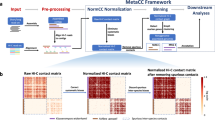Abstract
The problem of analysing bacterial isolates in order to detect plasmids has been widely studied. With the development of Whole Genome Sequencing (WGS) technologies, several approaches have been proposed to bin contigs into putative plasmids. Reference-based approaches aim to bin contigs by mapping or comparing their sequences against databases of previously identified plasmids or plasmid genes. On the other hand, de novo approaches use contig features such as read coverage and length for plasmid binning. Hybrid approaches that combine both strategies have also been proposed recently.
We present PlasBin a mixed integer linear programming based hybrid approach for plasmid binning. We evaluate the performance of several binning methods on a real data set of bacterial samples.
Access this chapter
Tax calculation will be finalised at checkout
Purchases are for personal use only
Similar content being viewed by others
Notes
- 1.
We rely on Unicycler as it is a widely used bacterial genome assembler, but any assembler providing an assembly graph can be used.
- 2.
Our data set did not contain any samples from Acinetobacter baumannii.
References
Antipov, D., Hartwick, N., Shen, M.W., Raiko, M., Lapidus, A.L., Pevzner, P.A.: plasmidSPAdes: assembling plasmids from whole genome sequencing data. Bioinformatics 32(22), 3380–3387 (2016). https://doi.org/10.1093/bioinformatics/btw493
Arredondo-Alonso, S., et al.: gplas: a comprehensive tool for plasmid analysis using short-read graphs. Bioinformatics 36(12), 3874–3876 (2020). https://doi.org/10.1093/bioinformatics/btaa233
Arredondo-Alonso, S., et al.: mlplasmids: a user-friendly tool to predict plasmid- and chromosome-derived sequences for single species. Microb. Genom. 4(11), e000224 (2018). https://doi.org/10.1099/mgen.0.000224
Bankevich, A., et al.: Spades: a new genome assembly algorithm and its applications to single-cell sequencing. J. Comput. Biol. 19(5), 455–477 (2012). https://doi.org/10.1089/cmb.2012.0021
Bertsimas, D., Tsitsiklis, J.: Introduction to Linear Optimization. Athena Scientific, 1st edn. (1997)
van der Graaf-van Bloois, L., Wagenaar, J.A., Zomer, A.L.: RFPlasmid: predicting plasmid sequences from short-read assembly data using machine learning. Microb. Genom. 7(11) (2021). https://doi.org/10.1099/mgen.0.000683
Camacho, C., et al.: BLAST+: architecture and applications. BMC Bioinf. 10, 421 (2009). https://doi.org/10.1186/1471-2105-10-421
Carattoli, A.: Plasmids and the spread of resistance. Int. J. Med. Microbiol. 303(6), 298–304 (2013). https://doi.org/10.1016/j.ijmm.2013.02.001
Carattoli, A., et al.: In silico detection and typing of plasmids using plasmidfinder and plasmid multilocus sequence typing. Antimicrob. Agents Chemother. 58(7), 3895–3903 (2014). https://doi.org/10.1128/AAC.02412-14
Dewar, A., et al.: Plasmids do not consistently stabilize cooperation across bacteria but may promote broad pathogen host-range. Nat. Ecol. Evol. 5(12), 1624–1636 (2021). https://doi.org/10.1038/s41559-021-01573-2
Krawczyk, P., Lipinski, L., Dziembowski, A.: Plasflow: predicting plasmid sequences in metagenomic data using genome signatures. Nucleic Acids Res. 46(6), e35 (2018). https://doi.org/10.1093/nar/gkx1321
Luo, L., et al.: Comparative genomics of Chinese and international isolates of Escherichia albertii: population structure and evolution of virulence and antimicrobial resistance. Microb. Genom. 7(12) (2021). https://doi.org/10.1099/mgen.0.000710
McCormick, G.P.: Computability of global solutions to factorable nonconvex programs: Part I—convex underestimating problems. Math. Program. 10(1), 147–175, e000224 (1976). https://doi.org/10.1007/BF01580665
Müller, R., Chauve, C.: HyAsP, a greedy tool for plasmids identification. Bioinformatics 35(21), 4436–4439 (2019). https://doi.org/10.1093/bioinformatics/btz413
Nishida, H.: Comparative analyses of base compositions, DNA sizes, and dinucleotide frequency profiles in archaeal and bacterial chromosomes and plasmids. Int. J. Evol. Biol. 2012, 342482 (2012). https://doi.org/10.1155/2012/342482
Pellow, D., Mizrahi, I., Shamir, R.: Plasclass improves plasmid sequence classification. PLoS Comput. Biol. 16(4), 1–9 (2020). https://doi.org/10.1371/journal.pcbi.1007781
Robertson, J., Nash, J.: MOB-suite: software tools for clustering, reconstruction and typing of plasmids from draft assemblies. Microb. Genom. 4(8), e000206 (2018). https://doi.org/10.1099/mgen.0.000206
Rozov, R., et al.: Recycler: an algorithm for detecting plasmids from de novo assembly graphs. Bioinformatics 33(4), 475–482 (2016). https://doi.org/10.1093/bioinformatics/btw651
Wick, R.R., Judd, L.M., Gorrie, C.L., Holt, K.E.: Unicycler: Resolving bacterial genome assemblies from short and long sequencing reads. PLoS Comput. Biol. 13(6), 1–22 (2017). https://doi.org/10.1371/journal.pcbi.1005595
Author information
Authors and Affiliations
Corresponding author
Editor information
Editors and Affiliations
Rights and permissions
Copyright information
© 2022 The Author(s), under exclusive license to Springer Nature Switzerland AG
About this paper
Cite this paper
Mane, A., Faizrahnemoon, M., Chauve, C. (2022). A Mixed Integer Linear Programming Algorithm for Plasmid Binning. In: Jin, L., Durand, D. (eds) Comparative Genomics. RECOMB-CG 2022. Lecture Notes in Computer Science(), vol 13234. Springer, Cham. https://doi.org/10.1007/978-3-031-06220-9_16
Download citation
DOI: https://doi.org/10.1007/978-3-031-06220-9_16
Published:
Publisher Name: Springer, Cham
Print ISBN: 978-3-031-06219-3
Online ISBN: 978-3-031-06220-9
eBook Packages: Computer ScienceComputer Science (R0)




